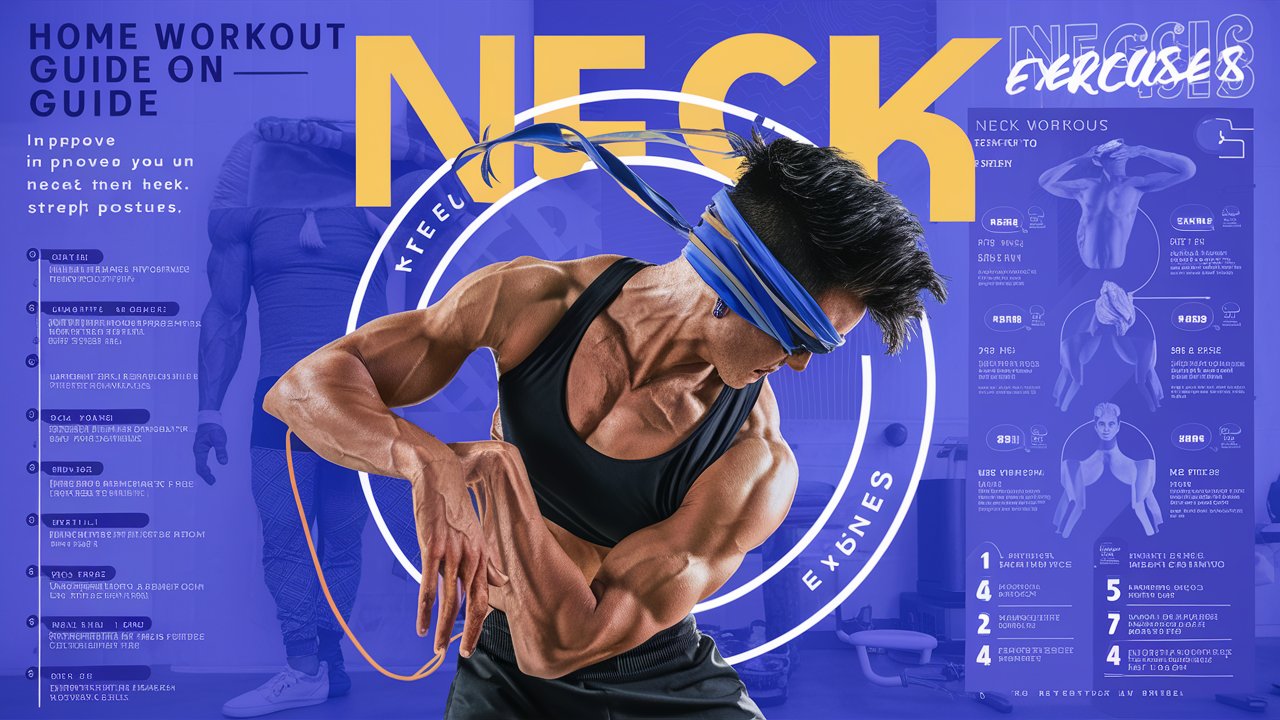Neck Workout at Home: Comprehensive Guide:
Importance of Neck Strengthening

The neck is a vital part of the body that supports the head and protects the spinal cord. Strengthening the neck muscles is crucial not only for overall health but also for enhancing athletic performance and preventing injuries. A strong neck can alleviate chronic pain, improve posture, and reduce the risk of neck and head injuries.
Table of Contents
Benefits of Neck Workouts
Engaging in regular neck workouts offers numerous benefits, including:
- Improved Posture: Strong neck muscles help maintain proper alignment of the spine.
- Reduced Neck Pain: Strengthening exercises can alleviate tension and pain in the neck and shoulders.
- Enhanced Athletic Performance: Athletes, particularly those in contact sports, benefit from a stronger neck which helps in absorbing impacts.
- Injury Prevention: A well-conditioned neck is less prone to strains and other injuries.
Safety Precautions
Before starting a neck workout routine, it’s essential to keep safety in mind:
- Consult a Professional: Especially if you have pre-existing conditions.
- Warm-Up Properly: Prepare the muscles to prevent injuries.
- Avoid Overexertion: Start with light exercises and gradually increase intensity.
- Maintain Proper Form: Incorrect techniques can lead to injury.
Anatomy of the Neck

Muscles Involved
The neck is composed of several muscles, each playing a crucial role in movement and support. Key muscles include:
- Sternocleidomastoid: Responsible for rotation and flexion of the head.
- Trapezius: Extends from the neck to the mid-back, aiding in moving the shoulder blades.
- Scalenes: Located on the sides of the neck, assisting in the first rib’s elevation and neck flexion.
Functions of Neck Muscles
Neck muscles are essential for various functions such as:
- Supporting the Head: Holding up and balancing the head’s weight.
- Facilitating Movement: Allowing the head to move in different directions.
- Protecting the Spine: Providing stability and protecting the spinal cord.
Common Issues and Injuries
Common neck issues include:
- Strains and Sprains: Often due to overuse or sudden movements.
- Herniated Discs: Can cause pain and numbness.
- Whiplash: Typically from car accidents, causing neck stiffness and pain.
Types of Neck Workouts
Isometric Exercises
Isometric exercises involve contracting the muscles without movement. These exercises are effective in building strength without putting stress on the joints.
Neck Flexion
Press your forehead against your hands, resisting the movement for a few seconds.
Neck Extension
Push the back of your head against your hands, maintaining resistance.
Lateral Flexion
Place your hand on the side of your head and push against it.
Rotation
Turn your head to one side and push against your hand to resist the movement.
Dynamic Exercises
Dynamic exercises involve movement and are excellent for improving flexibility and strength.
Chin Tucks
Tuck your chin towards your chest and hold for a few seconds.
Neck Rotations
Rotate your head slowly from side to side.
Forward and Backward Neck Tilt
Tilt your head forward and backward slowly and controlled.
Side Neck Tilt
Tilt your head to each side, bringing your ear towards your shoulder.
Equipment for Neck Workouts

No Equipment Needed
Many neck exercises can be performed without any equipment, making them accessible and easy to do at home.
Resistance Bands
Resistance bands can be used to add intensity to neck exercises.
Dumbbells
Light dumbbells can be utilized for certain neck exercises to increase resistance.
Neck Harness
A neck harness allows for weighted exercises, providing a greater challenge for advanced users.
Warm-Up Exercises
Neck Stretching
Proper warm-up prepares the neck muscles for the workout, reducing the risk of injury.
Forward Neck Stretch
Lower your chin to your chest and hold.
Side Neck Stretch
Tilt your head to the side, bringing your ear towards your shoulder.
Neck Rotation Stretch
Rotate your head slowly from side to side.
Shoulder Rolls
Roll your shoulders forward and backward to loosen up.
Arm Circles
Make large circles with your arms to increase blood flow.
Detailed Exercise Descriptions
Isometric Neck Flexion
- Starting Position: Sit or stand with a straight posture.
- Execution: Press your forehead against your hand, resisting the movement.
- Duration: Hold for 10-15 seconds.
Isometric Neck Extension
- Starting Position: Sit or stand with a straight posture.
- Execution: Push the back of your head against your hand.
- Duration: Hold for 10-15 seconds.
Isometric Lateral Flexion
- Starting Position: Sit or stand with a straight posture.
- Execution: Place your hand on the side of your head and push against it.
- Duration: Hold for 10-15 seconds on each side.
Isometric Neck Rotation
- Starting Position: Sit or stand with a straight posture.
- Execution: Turn your head to one side and push against your hand.
- Duration: Hold for 10-15 seconds on each side.
Dynamic Chin Tucks
- Starting Position: Sit or stand with a straight posture.
- Execution: Tuck your chin towards your chest.
- Repetitions: Perform 10-15 repetitions.
Dynamic Neck Rotations
- Starting Position: Sit or stand with a straight posture.
- Execution: Rotate your head slowly from side to side.
- Repetitions: Perform 10-15 repetitions.
Dynamic Forward and Backward Neck Tilt
- Starting Position: Sit or stand with a straight posture.
- Execution: Tilt your head forward and backward.
- Repetitions: Perform 10-15 repetitions.
Dynamic Side Neck Tilt
- Starting Position: Sit or stand with a straight posture.
- Execution: Tilt your head to each side.
- Repetitions: Perform 10-15 repetitions.
Creating a Neck Workout Routine
Frequency of Workouts
For optimal results, neck workouts should be performed 2-3 times per week.
Repetition and Sets
Start with 1-2 sets of each exercise, gradually increasing to 3-4 sets as you build strength.
Progressive Overload
Gradually increase the intensity by adding resistance or increasing duration.
Combining with Other Workouts
Incorporate neck exercises into your regular workout routine for balanced training.
Advanced Neck Exercises
Resistance Band Neck Flexion
- Starting Position: Attach a resistance band to a sturdy object.
- Execution: Perform neck flexion exercises against the band’s resistance.
Resistance Band Neck Extension
- Starting Position: Attach a resistance band to a sturdy object.
- Execution: Perform neck extension exercises against the band’s resistance.
Neck Harness Exercises
Use a neck harness for weighted neck flexion and extension exercises.
Weighted Neck Exercises
Incorporate light weights or dumbbells to add resistance to neck exercises.
Neck Workout for Athletes
Importance for Contact Sports
Athletes in contact sports benefit from strong neck muscles to absorb impacts and prevent injuries.
Specific Exercises for Athletes
Focus on exercises that enhance strength and flexibility, such as resistance band exercises and neck harness workouts.
Recovery and Maintenance
Ensure proper recovery with stretching and adequate rest to prevent overuse injuries.
Preventing Neck Injuries
Proper Technique
Always use correct form to avoid strain and injuries.
Importance of Warm-Up and Cool-Down
Warming up prepares the muscles, while cooling down aids in recovery.
Recognizing Signs of Overuse
Be aware of signs like persistent pain or stiffness and adjust your routine accordingly.
Personal Stories and Case Studies
Testimonials from Individuals
Real-life success stories highlight the benefits of neck workouts.
Case Study: Athlete Neck Rehabilitation
Detailed case study on an athlete’s recovery and the role of neck exercises.
Expert Insights
Quotes from Fitness Professionals
Incorporate advice and quotes from fitness experts on the importance of neck workouts.
Medical Perspectives on Neck Training
Medical professionals provide insights on the health benefits and safety of neck exercises.
- Also Read :
- Mike Tyson Neck Workout: Building Strength Like a Champ
- Arnold 6 Exercises – Original program and two newer editions
- 6 Exercises for Swollen Feet and Ankles
- Best Lower Trapezius Exercises
How often should I do neck workouts?
It’s recommended to perform neck workouts 2-3 times per week.
Can neck workouts help with neck pain?
Yes, strengthening the neck muscles can alleviate and prevent neck pain.
Is it safe to use weights for neck exercises?
Yes, but it’s essential to start with light weights and ensure proper form.
What are the benefits of neck workouts for athletes?
Neck workouts improve strength, flexibility, and help prevent injuries in athletes.
